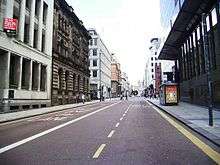Park Row, Leeds
_001.jpg)
Park Row is an important street in Leeds city centre, West Yorkshire, England. It divides the main financial districts from the main retail districts and forms a spine between City Square and The Headrow, two of Leeds' most sought after addresses. The street forms the western flank of the Public Transport Box, and as such is largely reserved for buses, taxis and cyclists. There is an exception for local access in some places.
Most of the city's main banks are located on the street, as well as being home to many large companies including Pinsent Masons and Deloitte.
The architecture of the street is representative of its prosperity. Many grand buildings can be found along the whole street, ranging from the modern granite Lloyds TSB building to the neo-classical Bank of England building.[1]
It is named Park Row because it was created as the eastern boundary of the long gone Manorial Park, used by the Lord for hunting.[2][3]
History

Britain's first permanent traffic lights were installed on Park Row at the junction with Bond Street in 1928 by Herbert Thorp.[4]
The street was home to the first Leeds City Museum, but its collection was largely damaged by German bombs in the Second World War, resulting in its closure in 1965. The collection has only recently been re-housed at the new Leeds City Museum in Millennium Square.[5]
Entertainment

Although during the day it is mainly concerned with the financial industry, at night it is at the centre of Leeds' nightlife culture. There is a high concentration of high-end restaurants along Park Row, as well as a number of cafes.
References
- ↑ http://www.bbc.co.uk/leeds/nature/city_centre/06.shtml
- ↑ http://www.leedscivictrust.org.uk/view.aspx?id=87
- ↑ http://www.thoresby.org.uk/history.htm
- ↑ "History of the city of Leeds". Leeds City Council. Archived from the original on 12 February 2012. Retrieved 10 October 2013.
- ↑ http://www.leodis.net/display.aspx?resourceIdentifier=2002514_95612735